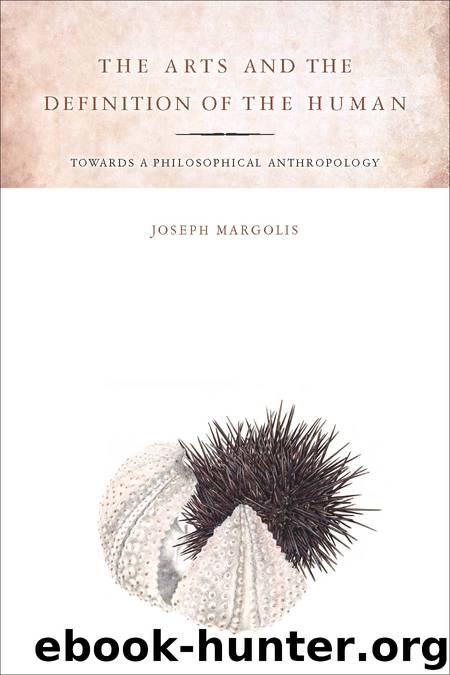The Arts and the Definition of the Human by Margolis Joseph

Author:Margolis, Joseph
Language: eng
Format: epub
Publisher: Stanford University Press
Published: 2011-07-26T16:00:00+00:00
I favor a strong distinction between the linear and punctal natures of non-Intentional and Intentional properties, respectively. But the significance of that difference gains its full force only when it is set in the larger context of a theory of physical and cultural phenomena. Let me add, without ceremony therefore, a series of ordered distinctions to strengthen its intended lesson.
First of all, there is no algorithmic way (and no approximation to same) for confirming referential or denotative success with regard to either physical or cultural things. Cultural phenomena are not poorer in this regard than physical phenomena. The best-known theories regarding reidentifying numerically distinct referents—from Frege to Kripke—utterly fail to solve the epistemic question; it cannot be done in any predicative way, and every strategy (including the causal theory of reference) finally depends on the predicative. Most discussants hardly make the effort.30
There is also no algorithmic way to confirm predicative similarity (through whatever variant manifestations may arise—as in the ancient puzzle of the One and the Many). Only if some form of Platonism could be made operative in cognitive terms (which no one believes) could the predication of non-Intentional attributes provide a possible basis for an extensional treatment of Intentional attributes. The result is that we usually subordinate all confidence in an exceptionless bivalent treatment of predication to the consensual tolerance of one or another viable society. This is close to Wittgenstein’s master theme in Philosophical Investigations, except that Wittgenstein pretty well ignores the question of the historicized process of lebensformlich practices and the related problems of interand intrasocietal divergences that could never preclude the relevance of relativistic and incommensurabilist options.31 But to admit any of these considerations would already defeat the unique-interpretation thesis—and obviously more.
Second, by distinguishing between “physical” and “cultural” entities, in the sense that the first lack and the second possess Intentional properties, we cannot fail to admit that artworks and histories are not “natural-kind” phenomena (though they remain “natural,” of course). But if that is so, and if cultural denotata can be individuated and reidentified with as much success as natural-kind entities, then apart from preserving coherence and discursive control, there is no reason to deny the distinction of intrinsically interpretable things—hence, no reason to deny that such things may be validly (alternatively) interpreted in incompatible ways that may be regarded as objective.
The cultural world honors its sui generis forms of diversity by constructing its own form of objective discourse. There’s an innovation no form of reductive materialism could possibly countenance. The analytic champions of the single-right-interpretation thesis (Beardsley and Danto, say) tend to oppose any theory that subverts the viability of reductive materialism, even if they themselves would never subscribe to the entire doctrine.
We may say that cultural entities lack “natures” (natural-kind natures), have “histories” instead, or have natures that are no more than histories (on their Intentional side). But we must also bear in mind that, qua real, cultural entities are, despite being artifactual, indissolubly embodied in material entities: hybrid second-natured selves, in the members of Homo sapiens; Michelangelo’s Moses, in a block of cut marble.
Download
This site does not store any files on its server. We only index and link to content provided by other sites. Please contact the content providers to delete copyright contents if any and email us, we'll remove relevant links or contents immediately.
The Leavers by Lisa Ko(6462)
Born to Run: by Christopher McDougall(6252)
iGen by Jean M. Twenge(4695)
Sapiens by Yuval Noah Harari(4531)
The Kite Runner by Khaled Hosseini(4417)
Spare by Prince Harry The Duke of Sussex(4188)
Bullshit Jobs by David Graeber(3173)
Livewired by David Eagleman(3117)
Goodbye Paradise(2951)
Never by Ken Follett(2873)
A Dictionary of Sociology by Unknown(2516)
Harry Potter 4 - Harry Potter and The Goblet of Fire by J.K.Rowling(2414)
The Club by A.L. Brooks(2352)
People of the Earth: An Introduction to World Prehistory by Dr. Brian Fagan & Nadia Durrani(2345)
The Social Psychology of Inequality by Unknown(2305)
Machine Learning at Scale with H2O by Gregory Keys | David Whiting(2269)
Harry Potter and the Order of the Phoenix (5) by J.K. Rowling(2224)
0041152001443424520 .pdf by Unknown(2214)
Don't Sleep, There Are Snakes by Daniel L. Everett(2213)
